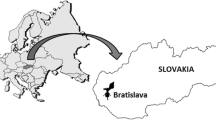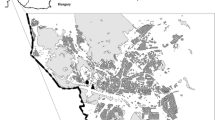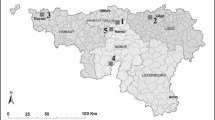Abstract
The airborne sporangia of Oomycota, including Phytophthora species and other species, are usually recorded by volumetric spore traps. The aim of this work was to create a predictive model for the seasonality and weather parameters that may affect sporangia distribution by analysing their presence over the course of a year. Three Hirst spore traps were located in the SW of Spain (Plasencia, Don Benito and Zafra), and the presence of sporangia was recorded throughout 2012–2013. Phytophthora sporangia were recorded on 76–110 days per year. Autumn and spring were the seasons when the highest concentration peaks of airborne sporangia were recorded; these peaks were recorded on the same day in each of the three locations. When analysing weekly sums of the daily concentration of sporangia, there was a statistically significant correlation between the sporangia concentration and amount of rain in the three locations studied; however, this correlation was not observed when comparing the individual daily concentrations. When comparing the daily concentration to the daily rain levels, the highest correlation coefficient and statistically significant correlation was reached on the second day after rain. The proposed predictive model considered the previous rain to be the main environmental factor. Holm oak and cork oak woods in Plasencia may be responsible for a higher concentration of airborne Phytophthora-type sporangia. Rain seems to have a direct influence on the concentration of airborne sporangia, but the highest concentrations appear on the second day after rain.







Similar content being viewed by others
References
Aylor, D. E. (1986). A framework for examining inter-regional aerial transport of fungal spores. Agricultural and Forest Meteorology, 38, 263–288.
Aylor, D. E. (1999). Biophysical scaling and the passive dispersal of fungus spores: relationship to integrated pest management strategies. Agricultural and Forest Meteorology, 97, 275–292.
Aylor, D. E., & Taylor, G. S. (1983). Escape of Peronospora tabacina spores from a field of diseased tobacco plants. Phytopathology, 73, 525–529.
Aylor, D. E., Fry, W. E., Mayton, H., & Andrade-Piedra, J. L. (2001). Quantifying the rate of release and escape of Phytophthora infestans sporangia from a potato canopy. Phytopathology, 91, 1189–1196.
Aylor, D. E., David, G., Schmale, M., Shields, J., Newcomb, M., & Nappo, C. J. (2011). Tracking the potato late blight pathogen in the atmosphere using unmanned aerial vehicles and Lagrangian modeling. Agricultural and Forest Meteorology, 151, 251–260.
Barber, P. A., Paap, T., Burgess, T. I., Dunstan, W., & Hardy, G. E. S. J. (2013). A diverse range of Phytophthora species are associated with dying urban trees. Urban Forestry and Urban Greening, 12, 569–575.
Bergot, M., Cloppet, E., Pérarnaud, V., Déqué, M., & Desprez-Loustau, M. L. (2004). Simulation of potential range expansion of oak disease caused by Phytophthora cinnamomi under climate change. Global Change Biology, 10, 1539–1552.
Blaeser, M., & Weltzien, H. C. (1978). The importance of sporulation, dispersal, and germination of sporangia of Plasmopara viticola. Zeitschrift fur Pflanzenkrankheiten und Pflanzenschutz – Journal of Plant Diseases and Protection, 85, 155–161.
Brasier, C. M. (1996). Phytophthora cinnamomi and oak decline in Southern Europe. Environmental constraints including climate change. Annals of Science Forest, 53, 347–358.
Bugiani, R., Govoni, P., Bottazzi, R., Giannico, P., Montini, B., & Pozza, M. (1995). Monitoring airborne concentrations of sporangia of Phytophthora infestans in relation to tomato late blight in Emilia Romagna, Italy. Aerobiologia, 11, 41–46.
Byrne, J. M., Hausbeck, M. K., & Sconyers, L. E. (2005). Influence of environment on atmospheric concentrations of Peronospora antirrhini sporangia in field-grown snapdragon. Plant Diseases, 89, 1060–1066.
Caffi, T., Gilardi, G., Monchiero, M., & Rossi, V. (2013). Production and release of asexual sporangia in Plasmopara viticola. Phytopathology, 103, 64–73.
Caubel, J., Launay, M., Lannou, C., & Brisson, N. (2012). Generic response functions to simulate climate-based processes in models for the development of airborne fungal crop pathogens. Ecological Modelling, 242, 92–104.
Corcobado, T., Cubera, E., Moreno, G., & Solla, A. (2013). Quercus ilex forests are influenced by annual variations in water table, soil water deficit and fine root loss caused by Phytophthora cinnamomi. Agricultural and Forest Meteorology, 169, 92–99.
Couzens, B. J., & Evans, E. (1968). The spread of potato blight (Phytophthora infestans) within the crop. Transactions of the British Mycological Society, 51, 461–467.
Cruickshank, I. A. M. (1963). Environment and sporulation in phytopathogenic fungi. IV. The effect of light on the formation of conidia of Peronospora tabacina Adam. Australian Journal of Biology Science, 16, 88–98.
Davidson, J. M., Wickland, A. C., Patterson, H. A., Falk, K. R., & Rizzo, D. M. (2005). Transmission of Phytophthora ramorum in mixed-evergreen forest in California. Phytopathology, 95, 587–596.
Deacon JW (2005) Fungal Biology. John Wiley & Sons, 4° Edition.
Erwin, D. C., & Ribeiro, O. K. (1996). Phytophthora diseases worldwide. St. Paul: The American Phytopathological Society.
Fall, M. L., Van der Heyden, H., Brodeur, L., Leclerc, Y., Moreau, G., & Cariss, O. (2014). Spatiotemporal variation in airborne sporangia of Phytophthora infestans: characterization and initiatives towards improving potato late blight risk estimation. Plant Pathology On-line. doi:10.1111/ppa.12235.
Friedrich, S., Leinhos, G. M. E., & Löpmeier, F.-J. (2003). Development of ZWIPERO, a model forecasting sporulation and infection periods of onion downy mildew based on meteorological data. European Journal of Plant Pathology, 109, 35–45.
Galán, C., Cariñanos, P., Alcázar, P., & Domínguez, E. (2007). Manual de calidad y gestión de la Red Española de Aerobiología. Spain: Servicio de Publicaciones de la Universidad de Córdoba.
Gobbina, D., Jerminib, M., Loskillc, B., Pertotd, I., Raynale, M., & Gesslera, C. (2005). Importance of secondary inoculum of Plasmopara viticola to epidemics of grapevine downy mildew. Plant Pathology, 54, 522–534.
Grünwald, N. J., Garbelotto, M., Goss, E. M., Heungens, K., & Prospero, S. (2012). Emergence of the sudden oak death pathogen Phytophthora ramorum. Trends in Microbiology, 20, 131–138.
Harwood, T. D., Xu, X., Pautasso, M., Jeger, M. L., & Shaw, M. W. (2009). Epidemiological risk assessment using linked network and grid based modelling: Phytophthora ramorum and Phytophthora kernoviae in the UK. Ecological Modelling, 220, 3353–3361.
Hirst, J. M. (1952). An automatic volumetric spore trap. Annals of Applied Biology, 39, 257–265.
Iglesias, I., Escuredo, O., Seijo, C., & Méndez, J. (2010). Phytophthora infestans Prediction for a potato crop. American Journal of Potato Research, 87, 32–40.
Jeger, M. K., & Pautasso, M. (2008). Comparative epidemiology of zoosporic plant pathogens. European Journal of Plant Pathology, 122, 111–126. doi:10.1007/s10658-008-9289-y.
Kennedy, R., & Wakeham, A. (2008). Development of detection systems for the sporangia of Peronospora destructor. European Journal of Plant Pathology, 122, 147–155.
Manici, L. M., Bregaglio, S., Fumagalli, D., & Donatelli, M. (2014). Modelling soil borne fungal pathogens of arable crops under climate change. International Journal of Biometerology, 58, 2071–83. doi:10.1007/s00484-014-0808-6.
Picco, A. M. (1992). Presence in the atmosphere of vine and tomato pathogens. Aerobiologia, 8, 459–463.
Reineria-Diaz, M., Iglesias, I., & Jato, M. V. (1997). Airborne concentrations of Botrytis, Uncinula and Plasmopara spores in a vineyard in Leiro-Ourense (N.W. Spain). Aerobiologia, 13, 31–35.
Ristaino, J. B., & Gumpertz, M. L. (2000). New frontiers in the study of dispersal and spatial analysis of epidemics caused by species in the genus Phytophthora. Annual Review of Phytopathology, 38, 541–576.
Rodríguez-Molina, M. C., Santiago-Merino, R., & Blanco, A. (2003). Detección de Phytophthora cinnamomi en dehesas de Extremadura afectadas por “seca” y su comportamiento in vitro. Boletín de Sanidad Vegetal y Plagas, 29, 627–640.
Rossi, V., & Caffi, T. (2012). The role of rain in dispersal of the primary inoculum of Plasmopara viticola. Phytopathology, 102, 158–65.
Royle, D. J., & Thomas, G. E. (1971). Analysis of relationships between weather factors and concentrations of airborne sporangia of Pseudoperonospora humuli. Transaction of the British Mycological Society, 58, 79–89.
Vercesi, A., Toffolatti, S. L., Zocchi, G., Guglielmann, R., & Ironi, L. (2010). A new approach to modelling the dynamics of oospore germination in Plasmopara viticola. European Journal of Plant Pathology, 128, 113–126. doi:10.1007/s10658-010-9635-8.
Voglmayr, H. (2008). Progress and challenges in systematics of downy mildews and white blister rusts: new insights from genes and morphology. European Journal of Plant Pathology, 122, 3–18.
Yao, C., Pal-Arya, S., Davis, J., & Main, C. E. (1997). A numerical model of the transport and diffusion of Peronospora tabacina spores in the evolving atmospheric boundary layer. Atmospheric Environment, 31, 1709–1714.
Acknowledgments
This work was made possible by research projects PRI06A190 and PRI BS10008 financed by the Regional Government, Junta de Extremadura (Spain) and the European Regional Development Fund.
Author information
Authors and Affiliations
Corresponding author
Rights and permissions
About this article
Cite this article
Manzano, J.M.M., Molina, R.T., Rodríguez, S.F. et al. Airborne propagules of Phytophthora and related taxa in SW Spain including a predictive model. Eur J Plant Pathol 143, 473–483 (2015). https://doi.org/10.1007/s10658-015-0700-1
Accepted:
Published:
Issue Date:
DOI: https://doi.org/10.1007/s10658-015-0700-1




